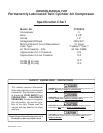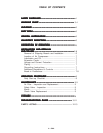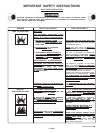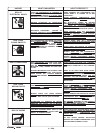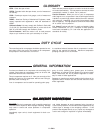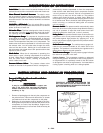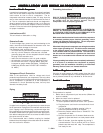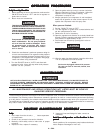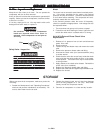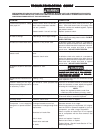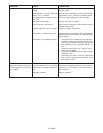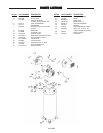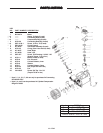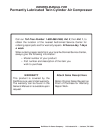
8 ENG
UNIT CYCLES AUTOMATICALLY WHEN POWER IS ON. WHEN DOING MAINTENANCE, YOU MAY BE EXPOSED TO
VOLTAGE SOURCES, COMPRESSED AIR OR MOVING PARTS. PERSONAL INJURIES CAN OCCUR. BEFORE
PERFORMING ANY MAINTENANCE OR REPAIR, DISCONNECT POWER SOURCE FROM THE COMPRESSOR AND
BLEED OFF ALL AIR PRESSURE.
Daily:Daily:
Daily:Daily:
Daily:
1. Drain water from the air tank, any moisture separators
or transformers.
2. Check for any unusual noise and/or vibration.
3. Manually check safety valve to make sure of proper
operation.
4. Inspect air filter, replace if necessary.
5. Inspect air lines and fittings for leaks; correct as
necessary.
Each Year of Operation or if a Problem is Sus-Each Year of Operation or if a Problem is Sus-
Each Year of Operation or if a Problem is Sus-Each Year of Operation or if a Problem is Sus-
Each Year of Operation or if a Problem is Sus-
pected:pected:
pected:pected:
pected:
Check condition of air compressor pump intake and exhaust
valves. Replace if damaged or worn out.
To ensure efficient operation and longer life of the air compressor outfit, a routine maintenance schedule should be prepared
and followed. The following routine maintenance schedule is geared to an outfit in a normal working environment operating
on a daily basis. If necessary, the schedule should be modified to suit the conditions under which your compressor is used.
The modifications will depend upon the hours of operation and the working environment. Compressor outfits in an extremely
dirty and/or hostile environment will require a greater frequency of all maintenance checks.
MAINTENANCEMAINTENANCE
MAINTENANCEMAINTENANCE
MAINTENANCE
ALL MAINTENANCE AND REPAIR OPERATIONS NOT LISTED MUST BE DONE BY
QUALIFIED SERVICE PERSONNEL.
ROUTINE MAINTENANCE SCHEDULEROUTINE MAINTENANCE SCHEDULE
ROUTINE MAINTENANCE SCHEDULEROUTINE MAINTENANCE SCHEDULE
ROUTINE MAINTENANCE SCHEDULE
OPERATING PROCEDURESOPERATING PROCEDURES
OPERATING PROCEDURESOPERATING PROCEDURES
OPERATING PROCEDURES
Daily Start-Up ChecklistDaily Start-Up Checklist
Daily Start-Up ChecklistDaily Start-Up Checklist
Daily Start-Up Checklist
1. Before attaching air hose or accessories, make sure the
ON/AUTO lever is set to “OFF” and the air regulator or
globe valve is closed.
2. Attach hose and accessories.
TOO MUCH AIR PRESSURE CAUSES A HAZARD-
OUS RISK OF BURSTING. CHECK THE MANUFAC-
TURER'S MAXIMUM PRESSURE RATING FOR AIR
TOOLS AND ACCESSORIES. THE REGULATOR
OUTLET PRESSURE MUST NEVER EXCEED THE
MAXIMUM PRESSURE RATING.
Compressed air from the outfit may contain
water condensation. Do not spray unfiltered
air at an item that could be damaged. Some
air operated tools or devices may require
filtered air. Read the instructions for the air
tool or device.
3. Check the manufacturer’s maximum pressure rating for
air tools and accessories.The regulator outlet pressure
must never exceed the maximum pressure rating. If your
compressor is not supplied with a regulator with gauge,
install one before using accessories.
4. Turn the ON/AUTO lever to “AUTO” and allow tank
pressure to build. Motor will stop when tank pressure
reaches “cut-out” pressure.
WATER WILL CONDENSE IN THE AIR TANK. IF NOTWATER WILL CONDENSE IN THE AIR TANK. IF NOT
WATER WILL CONDENSE IN THE AIR TANK. IF NOTWATER WILL CONDENSE IN THE AIR TANK. IF NOT
WATER WILL CONDENSE IN THE AIR TANK. IF NOT
DRAINED, WATER WILL CORRODE AND WEAKEN THEDRAINED, WATER WILL CORRODE AND WEAKEN THE
DRAINED, WATER WILL CORRODE AND WEAKEN THEDRAINED, WATER WILL CORRODE AND WEAKEN THE
DRAINED, WATER WILL CORRODE AND WEAKEN THE
AIR TANK CAUSING A RISK OF AIR TANK RUPTURE.AIR TANK CAUSING A RISK OF AIR TANK RUPTURE.
AIR TANK CAUSING A RISK OF AIR TANK RUPTURE.AIR TANK CAUSING A RISK OF AIR TANK RUPTURE.
AIR TANK CAUSING A RISK OF AIR TANK RUPTURE.
12. After the water has been drained, close the drain valve.
The air compressor can now be stored.
NOTE
If drain valve is plugged, release all air pressure.
The valve can then be removed, cleaned, then
reinstalled.
5. Open the globe valve by turning it counter clockwise.
Open the regulator by turning it clockwise. Adjust the
regulator to the correct pressure setting. Your
compressor is ready for use.
6. Always operate the air compressor in well-ventilated
areas; free of gasoline or other solvent vapors. Do not
operate the compressor near the spray area.
When you are finished:
7. Set the “ON/AUTO” lever to “OFF”.
8. Turn the regulator or globe valve counterclockwise and
set the outlet pressure to zero.
9. Remove the air tool or accessory.
10. Open the regulator and allow the air to slowly bleed from
the tank. Close the regulator tank and/or globe valve when
tank pressure is approximately 20 psi.
11. Drain water from air tank by opening drain valve on
bottom of tank.



